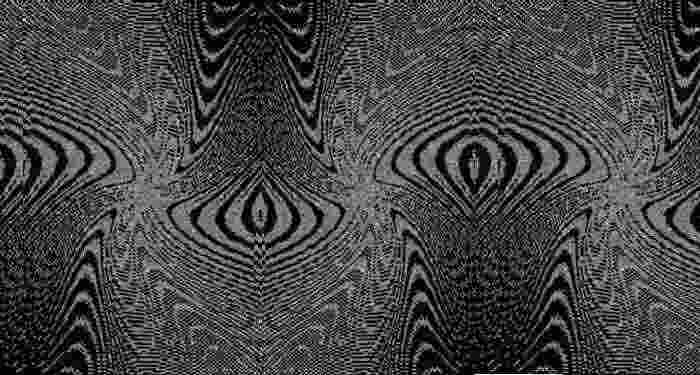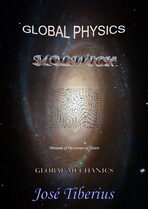3.c) Bonds of atoms and molecules
Atoms and molecules form normal matter, which we detect directly by our senses. In the previous sections, we have seen the new atomic theory of Global Mechanics; now, we are going to try to explain the composition of molecules and their properties from the same perspective.
Global Mechanics allows one to visualize the atoms and molecules in the reticular structure of matter or Global Aether by presenting elementary particles as loops or curls of this structure, forces of attraction as gravity and electromagnetism, and, finally, forces of repulsion as negative gravity or also electromagnetism.
One should also remember the concept of temperature or movement of the atoms and molecules –with a stationary or vibrating nature–, which relaxes the electromagnetic tension between the atomic nucleus and its surroundings.
Molecules signify restrictions in the individual movement of atoms, whether they are molecules of a pure element or molecules with atoms of various chemical elements. These restrictions are primarily a consequence of molecular bonds.
The principal types of molecular bonds are the following:
Ionic bond
Due to the energy barrier from the stability of electrons, an atom can lose an electron to another atom to form an ionic bond. In any case, it is essential to understand what electrons are and why they form where they form; that is, not only the electron transfer but also there is a change in the spatial location and orientation of the atoms.
Simple physics experiment
Let us imagine a bed sheet spread out on the horizontal plane and fixed in the middle line. On each end, a person twists the sheet 90 degrees in the opposite direction. No loop will form on any of the sides, but if the horizontal line of the center is twisted 90 degrees in any direction, it will produce a loop or twist of 180 degrees on one side, and the original 90-degree twist on the other end will disappear.
Covalent Bond
The covalent bond occurs when two or more atoms share electrons in a molecular orbital.
The rules put forth by Global Mechanics regarding the gravito-magnetic equilibrium of the electron orbits in an atom should apply to the set of forces brought about by the presence of more atoms, resulting in orbitals throughout the molecules.
The covalent bond of molecules is quite a bit stronger than the ionic bond since the atoms would be closer and the energy barrier of electron stability will tend to keep these atoms together.
The page Gravity at short distances in the section on the Gravitational interaction gives us another perspective. The electrons of a covalent bond imply a joining force between two atoms of a molecule and, at the same time, prevent the atoms from getting even closer together.
Simple physics experiment
Make a slipknot on two parallel strings. Separate both of them at one of the ends, and verify that the knot or half-knot cannot get close to this end without becoming undone.
The mechanisms of stability in molecules are similar in their principal characteristics to those of the electron configuration of the atom. Therefore, when one atom in a covalent bond has more electronegativity, it will be a polar covalent bond. The ionic bond would appear in the limit of the polarity of the covalent bond.
Metallic bond
Electrons move as electron clouds in covalent bonds in networks of tightly bonded atoms. This structure and the considerable mobility of the electrons are responsible for the characteristic properties of metals.

We have stated that molecules signify restrictions in the movement of atoms, but there also restrictions on the movement of molecules –such as, for example, covalent bonds in networks, or metallic bonds themselves.
The phases of matter, solid, liquid, and gas, reflect the atomic and molecular structures as the individual movement of atoms and molecules and other characteristics or properties, such as hardness, malleability, conductivity, or, solubility.
Let us take a look, at an attempt with specific renormalizable details, of the effect of temperature on the three physical phases of matter:
Solid phase of matter
Atoms and molecules need to move simultaneously since the loops of the three-dimensional structure of matter do not permit molecules to move individually, whether this is due to network bonds, of the three-dimensional structure of molecules, or because of the existence of other spatial adjustments of gravito-magnetic differences with sufficient force.
However, with the increase in temperature, the nucleus of the atoms acquires more energy and mass, which increases the gravito-magnetic field and, as a result of the repulsive gravity at short distances, the points of electromagnetic relaxation that imply the orbits of electrons move away.
If this distancing cannot take place, there will be an increase in the vibration of the nuclei and the velocity of the electrons.
Liquid phase of matter
However, there will come a moment when the energy that temperature and vibration represent will produce certain molecular mobility that will give way to the liquid phase.
Gas phase of matter
The movement of the molecules is entirely independent, and an increase in temperature has a direct relationship to the kinetic energy, the elastic collisions between the molecules, and the pressure produced by the collisions with the walls that contain the volume of the gases.
On Wikipedia, one can find a lot of information and details about molecules, molecular bonds, and the physical phases of matter, though all the forces of the atom and molecules will have a virtual or mathematical nature.
The type of molecular bond explains the properties of the physical phases of each element or chemical compound mostly, but there are many other variables and significant exceptions. For example, one compound goes from solid to liquid with an increase in temperature. Then it goes back to being a solid before becoming liquid again, and then finally it becomes a gas.
